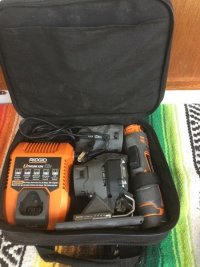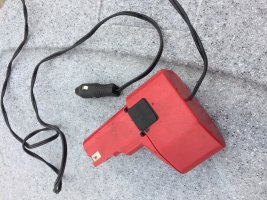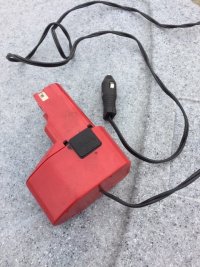Arcturus has gradually been accumulating his own dedicated set of tools. At first, I brought a box or two of tools from the shop every time I went to do a boat project. But that seemed to be every single time. So obviously a tool set was needed on board. But I still brought power tools from the shop. Then one day, when the boat was kept 100 miles away, I forgot to bring the all-important drill gun. So rather than drive 200 miles to fetch one, I stopped and bought Arcturus one for his very own. That was the beginning of a small collection of power tools. The most recent one brought up some issues, but I might as well say something about the others and why they should be on-board. Or why not. Some of this stuff is obvious and/or generic. Feel free to chime in.
That first tool was a "Rigid" brand 12 V LiIon drill from Home Depot. As near as I can determine, it's exactly the same drill sold under the "Milwaukee" brand, with a slightly different case and color. That was probably about four years ago now, and I've been very pleased with it.

To begin with, it's the smallest and lightest drill gun I've ever owned, but it seems as solid and powerful as the big ones. Compact is a good thing for the boat. It's got a little LED that illuminates what you're working on, which is very handy in the remote crevices of the boat. The batteries that it comes with are 16 Whr = 1.33 Amp hours - pretty small, but enough charge for most drilling jobs. And they hold their charge for months at a time. The only thing that it notably lacks is a hole for a lanyard - highly desirable for jobs done dangling in the bosuns chair at the mast head, and less perilous locations too. It also doesn't have a bubble-level like some others do, which is handy for keeping the drill straight and level. But of course, that wouldn't really work on the boat anyway, so it's no loss in this case. It does not have the second handle that you can screw in at right angles which many larger drill guns do, but this unit is so small and light that I don't think one is needed.

This particular unit came in a "starter kit" with a charger, two batteries, and a flashlight that uses the same battery. I've never really used that flashlight for anything - there's nothing special about it and it's usually more handy to grab the one kept at the companionway. The second battery is essential, given the small capacity.
Of course, the other part of a drill gun is the drill bits. I've got a slightly older version of this index set on board. I'm not sure if I bought it or inherited it. It's not bad as an inexpensive "starter" set. But there are some things about it and other sets like it...

To begin with, I do like index sets. I like to be able to find the bit I want quickly and be able to see at a glance if something is missing and needs to be replaced. And drill bits do need to be replaced, especially the ones for your most common fasteners - might as well buy them two or three at a time. This case does have two slots each for 1/8 and 1/4. But the bits in these sets are not always carbide-tipped or even very high quality, and drilling through a lot of fiberglass and metal will quickly dull them. (I keep a small bottle of 3-in-1 oil for drilling metal.) There is a lot of stuff in this set. Quite often, pre-made sets contain a lot of "filler" items that you will never use. I think I've used about two thirds of the times in this set at least once. The set does not have hex-shanks, which I prefer for hand-tightened chucks. Regular bits end up getting stuck in the hole and sucked right out of the chuck too often. I've gradually been replacing the ones that break with hex shanks. And there are a couple of larger bits I've had to buy for certain projects rolling around loose inside the box. For example, the forstner bit that I had to buy to finish the hatch project last week.

Finally, there is that case... possibly the most awkward object on the boat. It's made to hang inside a cabinet door, where I'm sure it would be very handy. Or on the wall behind a tool bench. But very difficult to store anywhere else. Some rainy Sunday afternoon, perhaps I'll get out a piece of sailcloth and sew up a tool roll to hold all my bits in an orderly indexed fashion, and leave out the ones that I don't use. Clearly, the best solution is to know in advance all the bits you will ever need, buy quality ones, and build a custom-made index holder that fits perfectly in your tool storage space.
That first tool was a "Rigid" brand 12 V LiIon drill from Home Depot. As near as I can determine, it's exactly the same drill sold under the "Milwaukee" brand, with a slightly different case and color. That was probably about four years ago now, and I've been very pleased with it.

To begin with, it's the smallest and lightest drill gun I've ever owned, but it seems as solid and powerful as the big ones. Compact is a good thing for the boat. It's got a little LED that illuminates what you're working on, which is very handy in the remote crevices of the boat. The batteries that it comes with are 16 Whr = 1.33 Amp hours - pretty small, but enough charge for most drilling jobs. And they hold their charge for months at a time. The only thing that it notably lacks is a hole for a lanyard - highly desirable for jobs done dangling in the bosuns chair at the mast head, and less perilous locations too. It also doesn't have a bubble-level like some others do, which is handy for keeping the drill straight and level. But of course, that wouldn't really work on the boat anyway, so it's no loss in this case. It does not have the second handle that you can screw in at right angles which many larger drill guns do, but this unit is so small and light that I don't think one is needed.

This particular unit came in a "starter kit" with a charger, two batteries, and a flashlight that uses the same battery. I've never really used that flashlight for anything - there's nothing special about it and it's usually more handy to grab the one kept at the companionway. The second battery is essential, given the small capacity.
Of course, the other part of a drill gun is the drill bits. I've got a slightly older version of this index set on board. I'm not sure if I bought it or inherited it. It's not bad as an inexpensive "starter" set. But there are some things about it and other sets like it...

To begin with, I do like index sets. I like to be able to find the bit I want quickly and be able to see at a glance if something is missing and needs to be replaced. And drill bits do need to be replaced, especially the ones for your most common fasteners - might as well buy them two or three at a time. This case does have two slots each for 1/8 and 1/4. But the bits in these sets are not always carbide-tipped or even very high quality, and drilling through a lot of fiberglass and metal will quickly dull them. (I keep a small bottle of 3-in-1 oil for drilling metal.) There is a lot of stuff in this set. Quite often, pre-made sets contain a lot of "filler" items that you will never use. I think I've used about two thirds of the times in this set at least once. The set does not have hex-shanks, which I prefer for hand-tightened chucks. Regular bits end up getting stuck in the hole and sucked right out of the chuck too often. I've gradually been replacing the ones that break with hex shanks. And there are a couple of larger bits I've had to buy for certain projects rolling around loose inside the box. For example, the forstner bit that I had to buy to finish the hatch project last week.

Finally, there is that case... possibly the most awkward object on the boat. It's made to hang inside a cabinet door, where I'm sure it would be very handy. Or on the wall behind a tool bench. But very difficult to store anywhere else. Some rainy Sunday afternoon, perhaps I'll get out a piece of sailcloth and sew up a tool roll to hold all my bits in an orderly indexed fashion, and leave out the ones that I don't use. Clearly, the best solution is to know in advance all the bits you will ever need, buy quality ones, and build a custom-made index holder that fits perfectly in your tool storage space.














